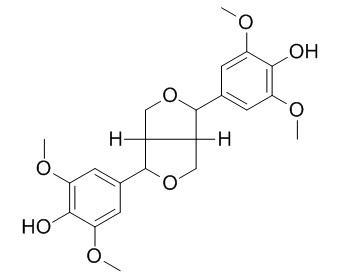DL-Syringaresinol
(+)-Syringaresinol shows inhibitory activity of Helicobacter pylori motility with the IC50 value is 50 microg/ml. (-)-Syringaresinol has been reported to potently inhibit the proliferation of human promyelocytic HL-60 cells through G 1 arrest and induction of apoptosis, suggests that it may be a potential chemotherapeutic agent for the treatment of cancer. Syringaresinol induces vasorelaxation by enhancing NO production in endothelial cells via two distinct mechanisms, phosphatidylinositol 3-kinase/Akt- and (PLC)/Ca2+/CaMKKβ -dependent eNOS phosphorylation and Ca(2+)-dependent eNOS dimerization. Syringaresinol also can protect against hypoxia/reoxygenation-induced cardiomyocytes injury and death by destabilization of HIF-1α in a FOXO3-dependent mechanism.
Inquire / Order:
manager@chemfaces.com
Technical Inquiries:
service@chemfaces.com
Tel:
+86-27-84237783
Fax:
+86-27-84254680
Address:
1 Building, No. 83, CheCheng Rd., Wuhan Economic and Technological Development Zone, Wuhan, Hubei 430056, PRC
Providing storage is as stated on the product vial and the vial is kept tightly sealed, the product can be stored for up to
24 months(2-8C).
Wherever possible, you should prepare and use solutions on the same day. However, if you need to make up stock solutions in advance, we recommend that you store the solution as aliquots in tightly sealed vials at -20C. Generally, these will be useable for up to two weeks. Before use, and prior to opening the vial we recommend that you allow your product to equilibrate to room temperature for at least 1 hour.
Need more advice on solubility, usage and handling? Please email to: service@chemfaces.com
The packaging of the product may have turned upside down during transportation, resulting in the natural compounds adhering to the neck or cap of the vial. take the vial out of its packaging and gently shake to let the compounds fall to the bottom of the vial. for liquid products, centrifuge at 200-500 RPM to gather the liquid at the bottom of the vial. try to avoid loss or contamination during handling.
Int J Mol Sci.2019, 20(14):E3538
Molecules.2024, 29(3):671.
Molecules.2019, 24(2):E343
Curr Issues Mol Biol.2024, 46(4):3328-3341.
Heliyon.2023, e12684.
Bulletin of Health Research2016, 44(4):279-286
Comput Biol Chem.2019, 83:107096
Enzyme Microb Technol.2022, 153:109941.
Mol Biol Rep.2022, doi: 10.1007
Sichuan Agricultural University2023, 4630743.
Related and Featured Products
Biol Pharm Bull. 2006 Jan;29(1):172-3.
Inhibition of Helicobacter pylori motility by (+)-Syringaresinol from unripe Japanese aprico[Pubmed:
16394533]
METHODS AND RESULTS:
A methanol extract from unripe Japanese apricot showed inhibitory activity of Helicobacter pylori motility. Inhibitory compound 1 was isolated and identified as (+)-syringaresinol (1) by spectoroscopic means. (+)-Syringaresinol (1) inhibited >90% of the H. pylori motility at a concentration of 500 microg/ml and the IC50 value was 50 microg/ml.
Int Immunopharmacol. 2008 Jul;8(7):967-73.
(-)-Syringaresinol inhibits proliferation of human promyelocytic HL-60 leukemia cells via G1 arrest and apoptosis.[Pubmed:
18486907]
METHODS AND RESULTS:
The induction of apoptosis after treatment with (-)-syringaresinol for 24 h was demonstrated by morphological changes, DNA fragmentation, altered ratio of Bax/Bcl-2, cleavage of poly(ADP-ribose) polymerase and flow cytometry analysis. (-)-Syringaresinol also induced cytochrome c release and activation of caspase-3 and caspase-9. To our knowledge, this is the first time that (-)-syringaresinol has been reported to potently inhibit the proliferation of human promyelocytic HL-60 cells through G(1) arrest and induction of apoptosis.
CONCLUSIONS:
These findings suggest that (-)-syringaresinol may be a potential chemotherapeutic agent for the treatment of cancer.
Chemische Berichte,1965,98(2):538–539.
Isolierung von DL-Syringaresinol aus Buchenholz[Reference:
WebLink]
METHODS AND RESULTS:
Bei der Perkolation von Buchenholz mit 2-proz. Essigsäure in der Hitze geht das Buchenlignin teilweise in Lösung. Unter den im Extrakt vorkommenden niedermolekularen Phenolen findet sich DL-Syringaresinol.



